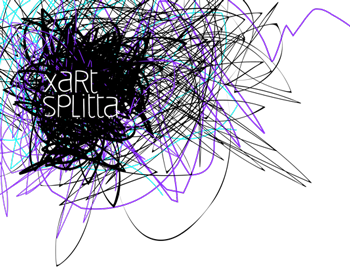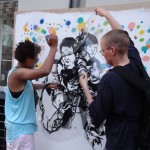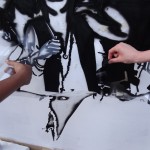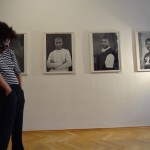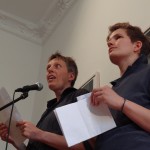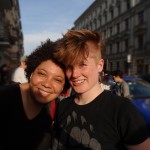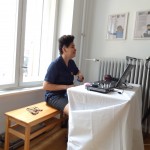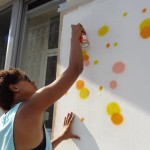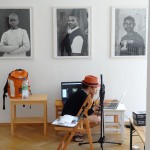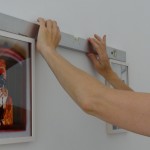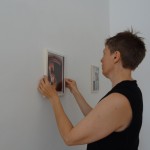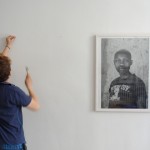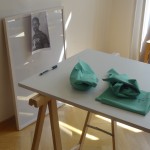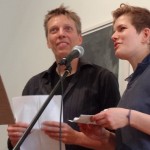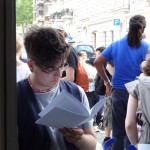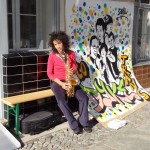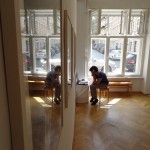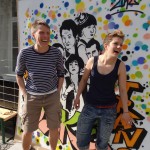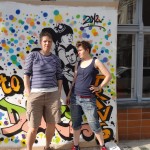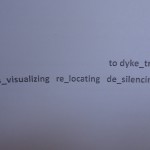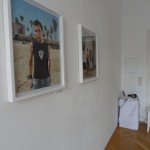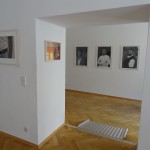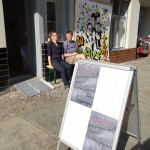we, ja’n and lann, decided to ask the artists to come up themselves with some kind of self-presentation that they would like to see_read_listen to in the context of a booklet for this exhibition. we also used info from the artists’ homepages for some of the presentations. for claude cahun, who is no longer alive, we had to find another solution.
anja weber
anja weber is a photographer and video-artist. anja produces her works in series and in un_disciplinary and collaborative ways. she develops her narrative-portraying photographic works in collaboration with the protagonists. questions on re_presentations_identities_localizations and space as well as their interconnections and interdependencies are important aspects of anja weber’s artistic production. reflecting upon both forms of performance and assertions of realism in photographic depictions is another aspect of anja’s work.
anja’s pieces always reflect the point in time when they are produced. the series california beautiful, started in 2007, investigates different concepts, forms of expression and appropriations of masculinities – starting from the idea that the categorization “man” is a socio-culturally framed norm.
in 2002, anja created a series with protagonists from the – at that time – very active drag king scene in berlin.
anja weber collaborates with other artists, as for example the sound artist sabine ercklentz. together they developed the audio-visual installation serious game (2009), based on portraits and interviews with trans*activists.
anja weber studied photography in dortmund (germany), exeter (uk) and new york. she was a fulbright scholar at new york university and the international center of photography.
anja lives in berlin.
http://www.anjaweber.com/
images exhibited:
Trystan, 2008, from the series: California Beautiful
Kalil, 2007, from the series: California Beautiful
Pussycoxx, 2002, from the series: Berlin Drag Kings
claude cahun
as claude cahun is no longer alive, we have formulated what is important to us concerning claude cahun in the context of the exhibition.
claude cahun (1894–1954), a photographer and writer who chose their own name. claude cahun lived in paris and the channel island jersey with marcel moore_suzanne malherbe during the nazi occupation. they collaborated in different artistic formats like photography, writing and political artistic interventions (for example in artistic opposition to the nazis).
one focus of claude cahun’s work is the self-portraits, which we perceive as questioning two-gender-norms and two-gendered images in many different ways.
however, claude cahun has not been exhibited very often up until now, and their work and life has also often been interpreted in heteronormative cisgendered ways. moreover, the intensive and life-long artistic and political collaboration between claude cahun and marcel moore is seldom acknowledged.
many of claude cahun’s works, photography as well as writing, can be found in the jersey heritage collection: http://jerseyheritagetrust.jeron.je/
the recent novel diese gezeiten by katharina geiser, written in german, trans_forms some of claude cahun’s and marcel moore’s writings and artistic interventions into a narration about their life on jersey.
images exhibited:
self-portrait, 1928
self-portrait, circa 1938
self-portrait, 1916
self-portrait, 1928
coco riot
a queer spanish migrant artist living in canada, coco riot believes that art is not a tool for social change but social change itself.
in their work, coco riot loves exploring the multiple social possibilities of drawing and language through installation, animation film, print media, graphic novels, comics and in-site drawing exhibitions. the topics that fuel their inspiration range from queer politics, social and personal memories, living in different languages and the experience of migration, to coco’s desire for bright colours and the love for poetry and repetitive patterns. in their work, coco riot uses personal experiences as metaphors to talk about social and political experiences.
coco’s work has been shown in museums, galleries and festivals from new york to barcelona, all through montreal, toronto, berlin, turin, madrid and a lot of friends’ living rooms.
oh! and coco uses the pronoun they and is the co-founder, with elisha lim, of the well-known trans art tumblr call me they.
http://cocoriot.com/
works exhibited:
trans pride online art project call me they together with elisha lim
video-poem los sentidos together with elisha lim
elisha lim
elisha lim is unusually happy to have been raised in an all-girls catholic convent on a tropical island. it may have motivated lim’s enthusiasm to celebrate and decorate queer people of colour, having such first hand experience of their charm and variety. elisha lim takes great pleasure in creatively portraying the beauty, dignity and power of being neither straight, nor white, nor cis-gendered. lim has illustrated novels, wall calendars, books and magazines with this mission, including the bitch magazine acclaimed sissy calendar, the illustrated gentleman, and most notably – 100 butches, a graphic novel of portraits and anecdotes about masculine queers.
100 butches earns a lot of publicity from its introduction by new york times bestselling author alison bechdel, and still accomplishes lim’s covert plan, with a 90% quota of racialized models, and an unabashed dedication “to queers of colour”.
http://elishalim.com/
works exhibited:
trans pride online art project call me they together with coco riot
graphics from the series 100 butches:
no 7: tomee
no 20: qiu jin
no 42: sherry
no 43: samira
video-poem los sentidos together with coco riot
goodyn green
goodyn green is a queer feminist photographer, born in aalborg/denmark 1979. she graduated as an art and history primary school teacher from n. zahles college of education in copenhagen in 2005, but after 2 years of teaching she decided to move to berlin to focus on photography. since the first issue in 2009, goodyn has been the main photographer of berlin based bend over magazine. the same magazine presented greens first photo collection, the catalog, with erotic images of androgynous looking queer women inspired by poses from classic gay porn magazines.
green often has a strong feminist agenda in creating awareness of female sexuality as “aggressive” as the depicted male sexuality, – through pornographic and erotic portraits of queer women.
currently she is working on a portrait project with models who identify as women, but who are frequently mistaken for another gender, harassed or insulted in public or private. through this green wants to put a focus on the uncountable variations of female expressions. furthermore she is busy photographing for her series mixed feelings – a series of photographs of women in intimate moments seen through green’s eyes as their lover or girlfriend.
http://goodyngreen.com/
works exhibited:
3 images from the series mixed feelings
ja’n sammla
my topics_ways_wordings_engagements in and with the exhibition:
presence. becoming present. being present in collective actions_collective acting. community. the importance of community. its fragility. dyke_trans-community as my self_concept of living_living through_living on and in and living in moments_tears_ rising_longing for strength.
sharedacting_thinking_moving_understanding * creating&searching * ent_ starren_berühren_ver_bünden * engaging * fließen&rauschen * de_fracturing _zusammen_setzen – to be present_in being here and now_in the process and in the struggles. being present_being in contact in my works_reflections_activisms in dyke_transing utopian acting. with utopia as everyday action.
the podcasts exhibited are audio-collages of recordings created on 4 derivas – collective_connecting movings_walkings through berlin in small groups of 2 to 4. on the derivas, we visited locations and talked about localizations of empowering and interventional actions_wordings_connections in dyke_transed contexts. i understand the podcasts as momentary_fragile _searching presences of collective dyke_transing actions. thanx to the derivantykes for their commitment, connecting and sharing.
and thanx to lann for our sharing of the (for me) new and inspiring creative processes, for mutual creatings&searchings, for being in movement and letting our processes with the exhibition be moving&touching&shifting.
works exhibited:
podcast community. audio-collage aus: dyke_trans_feministische derivas zu utopischem handeln und community. 2011
podcast utopisches handeln. audio-collage aus: dyke_trans_feministische derivas zu utopischem handeln und community. 2011
justin time
justin time is a multi media artist, stonemason, linedance instructor, filmmaker, trans* curator, feminist, gender interrogator, cowboy, traveller and tango beginner. in my art projects i research and subvert the spheres of „normal“, appropriate and transform common myths and paradigms. i am likewise fascinated and nauseated by media constituted role types, so i use them, challenge them, try to slightly change their meanings and to take them ad absurdum. the goal of my works and projects is to stir things up and raise questions, for i don´t claim to know all the answers. what do you think you look at on the picture? how does a label affect your perception? why is it so important to know, to classify? maybe there´s no word for it?
http://justintimeproductions.de/
images exhibited:
natural, 2012
real, 2012
lann hornscheidt
since working most of all with linguistic practices, the making of a film on dyke_trans, together with layla zami, has been a new experience and an important step for transforming political knowledge productions for me. literary artistic productions, which i read as the dyke_transing of perceptions, have been important to me for a long time; and now here they are contextualized by various personal stories and perceptions of what dyke_transing means for different people. thanx to layla. thanx to all others engaged and involved in the making of the film!
for me, creating the exhibition together with ja’n has been processual_ challenging_widening_intensive unfinished_exciting_touching_moving spaces _times_forms. our movements_ways_traces through and with the exhibition, with artistic political actions, our openings_questionings_discussions_ hesitations, our perceiving_reading_despairing_disarriving with forms of interaction_work_exhibiting have been complex_beginnings_beings_a contact_communications. thanx ja’n.
work exhibited:
film: spuren legen_verwischen. a feminist videopoem, together with layla zami, 2012
layla zami
“dis_visualizing?”
solitary people and their surroundings. questioning and the quest for harmony. people stepping into new worlds, step by step creating their own worlds. the dreamer blowing away the stormy past and cloudy futures to create a second of eternity. the dancer’s body linking the ground she anchored and the air she s breathing. photographs sometimes bear traces of tenderness.
“re_locating?”
in exhibiting images, i am re-projecting a moment… but a new moment is created in the viewing context! the observers are free to project their own creativity. watching the viewers viewing, i feel how each one enters the exhibition space with their personal emotions. and i like to show you who is behind the camera. who am i in this photographic instant how do i relate to the people i photographed and how do you relate to them through me?
“de_silencing?”
de_silencing for me means voicing our dreams, naming ourselves and printing beautiful faces and spaces on a glossy paper. we are black indian jewish and so much more we are lesbians queer dykes we are not yin or yang we are both and we are beyond. we are no longer waiting in line for your magazines your preferences we re*create our own stories and spaces. we are loving lovers we are… beautiful!
this is how i relate to this exhibition and its concept. i thank lann, ja’n, the beautiful people (not forgetting myself;) i photographed, i thank my sista anouchK for her connecting spirit and i thank my muse oxana for her feminist loving.
ubuntu ngumuntu nga bantu
laYla Zami
http://www.laylazami.net/
works exhibited:
images:
mind blowing – Ilya Washington
reach out, move in – Oxana Chi
laYla by Layla Zami
film: spuren legen_verwischen. a feminist videopoem, together with lann hornscheidt, 2012
zanele muholi
zanele muholi was born in umlazi, durban, in 1972, and lives in cape town. she studied photography at the market photo workshop in newtown, johannesburg. she was a founder of the forum for the empowerment of women (few), a Black lesbian organisation based in gauteng. recent solo shows have taken place at the gladstone hotel in toronto and at fred, london (2010). she was the recipient of the 2005 tollman award for the visual arts, the first bhp billiton/wits university visual arts fellowship in 2006, and was the 2009 ida ely rubin artist-in-residence at the massachusetts institute of technology (mit). in 2009 she received a fanny ann eddy accolade from irn-africa for her outstanding contributions to the study of sexuality in africa. she also won the casa africa award for best female photographer and a fondation blachère award at les rencontres de bamako biennial of african photography in 2009. in 2010 her faces and phases series was included on the 29th são paulo biennale; the series was published by prestel and nominated as best photobook of 2010 at the international photobook festival in kassel.
zanele muholi is included on the group show tête-à-tête curated by mickalene thomas at rhona hoffman gallery, chicago (29 march to 5 may), and on appropriated landscapes at the walther collection, neu-ulm/burlafingen, germany (until may 2013). her award-winning documentary difficult love shows in st petersburg, together with an exhibition of prints, as part of the open eyes film festival against racism and xenophobia (13 to 23 april); at the 14th international women’s film festival in seoul (19 to 26 april); and at the lesbian spring festival in toulouse presented by bagdam espace lesbien on 21 april.
http://www.stevenson.info/artists/muholi.html
www.zanelemuholi.com
works exhibited:
images from the series only half the picture:
not butch but my legs are, 2005
what don’t you see when you look at me 1, 2004
images from the series new faces and phases:
zanele muholi, 2011
phumzile nkosi, 2011
matshidiso mofokeng, 2010
mpho mtsweni, 2010
performing artists at the opening night:
agnes lampkin (textperformance)
mother – person of color – basketballer – freelancer –freeminder – minder – actor – actress – agnes
born in gloucester (gb) 1973, moved to switzerland 1984
studied acting 1993-1996 at the hochschule der künste in zürich. since coming to germany in 1997 she has appeared onstage at the theaterhaus jena, theaterhaus stuttgart, schaubühne berlin, maxim gorki berlin, schauspiel essen, theater bielefeld, theater unterm dach, sophiensaele and at the english theatre berlin. in switzerland she has performed at the schauspielhaus zürich, theater basel, theater luzern and rote fabrik zürich among others.
nancy rohde (graffiti)
nancy rohde was educated as a painter/varnisher when she realized that she had a talent working with paint. from that point on, she started combining spraying with stenciling and realized that that was a good combination with graffiti.
nancy sprays graffiti in different social_political contexts like female clash (may 2012 berlin) and leads workshops with young people on graffiti, for example with the beraberce and culture on the road.
http://de-de.facebook.com/nancy.rohde.1
oxana chi (dance)
the themes and ideas of my work are based on my life and surroundings. it focuses on time-less, rest-less and dreams of how life could be. my dance shows as well our role in society, recalls our history, questions political movements. it brings different cultures and arts together to create a global art dance performance. something new – out – of it!
www.oxanachi.de
sonia lemos (dj-set)
sonia lemos is an ex-actress and ex-ballerina and the creator of mc xuparina, a dyke artist who sings/performs funk to save their soul. sonia lemos is a dj and plays soul and favela funk.
http://pt-br.facebook.com/mcxuparina
http://www.myspace.com/mcxuparina
